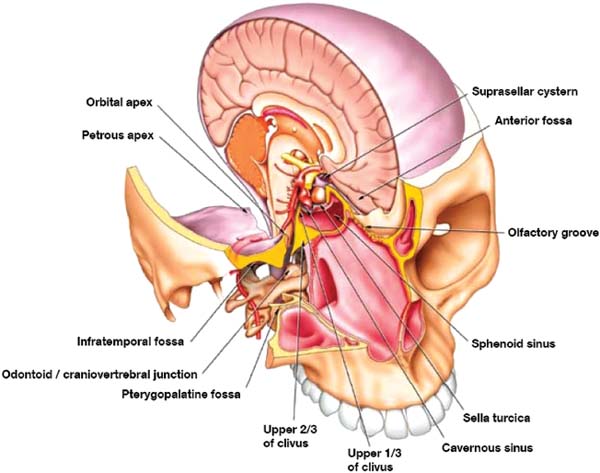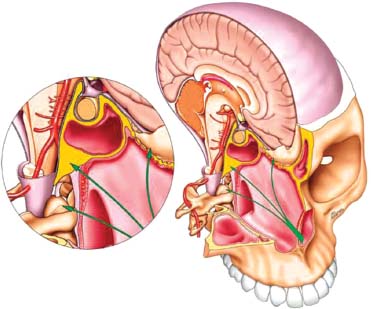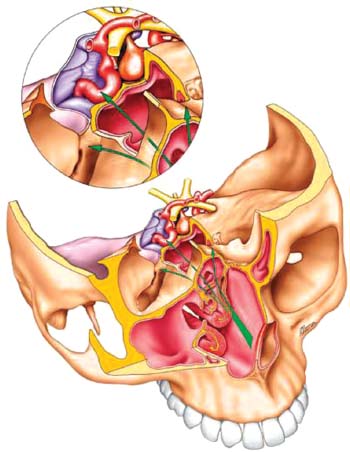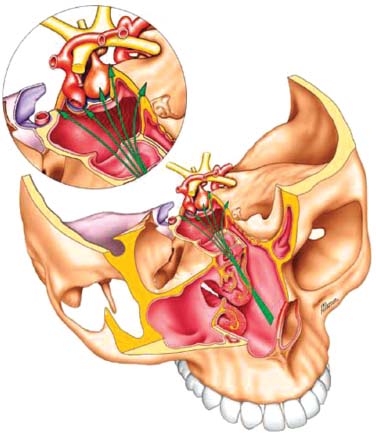33 Core Messages • Endoscopic endonasal approaches offer a minimal-access but maximally invasive alternative to traditional transfacial, transsphenoidal, and transcranial approaches to the anterior skull base. • The endoscope enables both a panoramic and a microscopic view of the anatomy during dissection, which may be further enhanced by the use of angular optics. • Because the skull base lies at the anatomic boundary between the fields of head and neck surgery and neurosurgery, the management of tumors in this region can benefit from the collaboration of both disciplines. • Reconstruction of the skull base is tailored to the individual case. If the dissection entails opening of the dura mater, a multilayered reconstruction using vascularized and nonvascularized components is appropriate. • Postoperative quality of life may be maintained or improved by the application of endoscopic approaches to tumor resection. The field of skull base surgery has undergone a rapid evolution over the past 15 years as endoscopic technology has gained increasing prominence.1 The wide acceptance of endoscopic sinus surgery by otolaryngologists, made possible by the availability of specialized fiberoptic equipment, has expanded the role of the rhinologic surgeon in the management of a variety of disease entities. Sequential developments of technique and ambition have led to endoscopic repair of cerebrospinal fluid (CSF) leaks, resection of sinonasal tumors, intracranial endoscopy, and neurosurgical applications. Other advances that have facilitated progress include digital video systems, specialized endoscopic instrumentation, new biological materials, and intraoperative navigation. Equally important is the spirit of collaboration that has been fostered between rhinologic surgeons and neurosurgeons, who have realized the benefits of a team approach for the treatment of skull base lesions. Refinements of surgical technique now permit completely endoscopic extirpation of tumors at the anterior skull base and enable reconstruction with a low rate of long-term sequellae. This chapter is intended to provide an overview of recent advances in endoscopic skull base surgery, which promise to enhance the field of head and neck oncologic surgery in exciting new ways. Success with endoscopic approaches to the skull base begins with appropriate patient selection. A wide variety of skull base tumors are amenable to endoscopic resection, which can be divided into extracranial and intracranial lesions (Fig. 33.1). Extracranial tumors are most commonly sinonasal in origin and include squamous cell carcinoma, adenocarcinoma, esthesioneuroblastoma, adenoid cystic carcinoma, and sinonasal mucosal melanoma. Nonsinonasal tumors that arise at the anterior skull base include chondrosarcoma, osteosarcoma, schwannoma, and juvenile nasopharyngioma. Intracranial tumors are predominantly benign lesions such as meningioma and craniopharyngioma, although low-grade malignancy such as chordoma and hemangiopericytoma are not uncommon. Pituitary adenoma, although benign, can be locally aggressive and produce substantial symptoms due to mass effect. Intracranial skull base malignancies are rare and include pituitary carcinoma and anaplastic meningioma. The primary goal of most skull base surgery is complete tumor resection, regardless of whether an open or endoscopic approach is used. The secondary goal is restoration of the anatomic barrier between extracranial and intracranial contents after tumor extirpation. In selected instances where clinical examination and imaging studies result in diagnostic uncertainty, an endoscopic approach may be chosen for biopsy. Debulking of a tumor in anticipation of postoperative radiotherapy, particularly for intracranial tumors, may also be a legitimate surgical goal. Finally, a role may exist for endoscopic surgery in the palliative care of patients with advanced skull base malignancy who suffer from nasal obstruction, sinusitis, visual loss, and other compressive symptoms.2 Figure 33.1 Skull base targets that can be accessed via endoscopic endonasal approaches. Printed with permission from: Schwartz TH, Fraser JF, Brown S, Tabaee A, Kacker A, Anand VK. Endoscopic cranial base surgery: classification of operative approaches. Neurosurgery 2008;62:996. © Wolters Kluwer Health. All rights reserved. Used with permission. Systematic review of the literature suggests that endoscopic approaches are equivalent or superior to traditional transcranial or microscope-assisted approaches for the resection of certain anterior skull base tumors.3 Meningiomas of the tuberculum sellae and planum sphenoidale have equivalent rates of gross total resection by endoscopic or open approaches (73.1 vs. 71.8%). In contrast, meningiomas of the olfactory groove present a greater challenge for endoscopic resection, reflected by a gross total resection rate of 63.2% compared with 92.9% by craniotomy. Endoscopic resection of clival chordoma is more likely to achieve gross total resection (61.0%) compared with transcranial approaches (48.0%), and also produces significantly fewer new cranial nerve deficits. Craniopharyngiomas have significantly higher rates of gross total resection by the endoscopic and microscope-assisted transsphenoidal approaches than by the transcranial route (66.9 vs. 69.1 vs. 48.3%). In addition, improved visual outcome is more likely by endoscopic resection than by transcranial resection (56 vs. 33%). A meta-analysis comparing endoscopic versus microscope-assisted transsphenoidal pituitary resection found that the endoscopic approach was associated with high rates of gross total resection, normalization of endocrine function, and improved vision.4 Direct comparison of endoscopic resection versus craniofacial resection for skull base malignancy has shown no differences in postoperative complication rate or survival, while operative time and length of hospital stay were reduced in the endoscopic resection group.5,6 Adherence to the principles of sound surgical technique is of central importance to endoscopic skull base surgery. The first principle is mastery of the pertinent anatomy, which begins with cadaveric study and continues with a stepwise progression of clinical experience. The second principle is obtaining excellent visualization of the surgical target and surrounding structures, which is facilitated by modern fiberoptic endoscopes that provide a view that is both panoramic and microscopic. The third principle is the maintenance of thorough hemostasis throughout the operation. The fourth principle is minimization of trauma to normal tissue, which can impair postoperative function and counters attempts at maintaining intraoperative hemostasis. The essential challenges of skull base surgery are complete tumor extirpation, reliable reconstruction of the skull base, and maintenance of patient’s quality of life. The high density of vascular and neurologic structures, as well as the potential for devastating sensory and functional deficits, demands that a highly developed surgical technique be used in the management of skull base lesions.7 A team-oriented approach between the rhinologic surgeon and the neurosurgeon is advantageous, beginning with preoperative evaluation of surgical goals and continuing throughout the operative procedure and postoperative period. In contrast to the dogma of most oncologic surgery, resection with wide local margins is not mandatory to achieve cure provided that all margins are microscopically free of tumor.5,8 Similarly, en bloc resection is less important than total tumor removal. Tumor extirpation with negative margins, rather than en bloc resection, has been shown to be an independent predictor of outcome in anterior skull base surgery.9 The endoscopic approach has not been shown to affect the ability to obtain negative margins.10 Regardless, the primary goal of tumor resection should never be compromised by the intention to perform endoscopic surgery, and the option to convert to an open approach to ensure clear margins should always be available. In selected cases, endoscopic and open transcranial approaches may be combined to enable complete tumor removal and reliable reconstruction.5,11 Early attempts at endoscopic skull base tumor resection met with limited acceptance due to a rate of postoperative CSF leak that exceeded 20% in some series.12,13 With the development of effective reconstructive strategies, postoperative leak rates have been significantly reduced to an overall rate below 5%, which is comparable to the leak rate for open transcranial approaches.14,15 Multilayered closure of the skull base defect remains the key aspect of complex skull base reconstruction. Creation of a watertight and airtight separation of extracranial and intracranial contents should not be compromised by the use of endoscopic techniques. The potential consequences of inadequate closure include CSF leak, meningitis, pneumocephalus, and death. An important consideration for all skull base approaches is the preservation of normal nasal anatomy and nasal function. Site-specific assessments after open skull base surgery have shown little detrimental effect on patient-reported quality of life.16,17 Similar assessments after endoscopic skull base surgery suggest that long-term improvements in quality of life are possible.18 Sinonasal-related quality of life carries particular interest, as the use of an endonasal approach has the potential to disrupt normal mucociliary function and sinus physiology.19 On the other hand, the use of endoscopic techniques during the approach may have a secondary benefit of correcting preexisting septal deviation, turbinate hypertrophy, or sinus ostium obstruction, which could translate to improved quality of life.20 The choice of reconstructive option may have an effect on sinonasal-related quality of life, which may be partly dependent on technique.18,20 Postoperative nasal crusting, which typically results from excessive mucosal trauma, has an influence on sinonasal-related quality of life and may persist for several months postoperatively.21 Another potentially significant source of reduced quality of life is olfactory dysfunction produced by injury to the olfactory neuroepithelium during the endonasal approach.22 In general, the destruction of normal sinonasal structures should be avoided with the intention of preserving postoperative function and patient’s quality of life. An exception to this principle is the case of sinonasal malignancy, in which the creation of a wide postoperative cavity is desirable to permit surveillance for tumor recurrence on routine examination. The limits of resectability have been defined for open cranial base approaches and are similar for endoscopic approaches. The intracranial portion of the carotid artery cannot be readily sacrificed, and manipulation carries the risk of dissection or hemorrhage with possibly catastrophic results. Involvement of the optic chiasm or bilateral optic nerves is an absolute contraindication to surgical resection. Relative contraindications include the involvement of brain parenchyma and orbital contents, as resection by endoscopic techniques is currently not practicable. Involvement of the bilateral cavernous sinus has been previously considered a contraindication, although the improved anatomic detail and microscopic control afforded by modern endoscopes have made possible the resection of such tumors. The anatomic limits of the endoscopic approaches continue to be defined. Currently, angled endoscopes can be used to visualize surgical resection as far anteriorly as the frontal sinus, and from lamina papyracea to lamina papyracea.23 Posteriorly, tumors involving the posterior clinoid processes and the intracranial third ventricle can be accessed by endoscopic techniques.24 The inferior extent is the craniocervical junction in a plane parallel to the hard palate, while the lateral limit is currently perceived as the parapharyngeal space and jugular foramen.25,26 Despite the narrow corridors used to provide the minimal-access approaches, the ultimate goal of endoscopic surgery is to perform resection as aggressively as with traditional approaches. There are several potential benefits of endoscopic surgery compared with traditional microscope-assisted transsphenoidal surgery.27 Trauma to the nasal mucosa can be minimized with the endoscopic approach, as there is no need for a retractor to create a visual corridor.28,29 The endoscopic field of view is panoramic, and angled telescopes can be applied to enable the surgeon to see around corners.29,30 Minimal violation of normal structures is required for access to the target, which has the potential to decrease operative time, obviate the need for nasal packing, and shorten hospital stays.28,29 With regard to traditional transfacial approaches, the endoscopic approaches avoid large skin incisions and eliminate excessive bony destruction that can contribute to significant pain and deformity. In addition, transfacial approaches can predispose to vestibular stenosis, facial hypoesthesia, and functional impairments. Risks carried by all endonasal approaches include crusting, synechiae, sinusitis, and vestibular abrasions. Excessive turbinate resection may result in excessive turbulent flow and paradoxical nasal obstruction, a disabling condition known as ozena. A systematic approach is beneficial when considering the endoscopic endonasal approaches to the skull base. The system described by Kassam et al divides the anterior skull base into anatomic planes and modules.23–25 Under that system, structures from the crista galli to the odontoid process are described in relation to the saggital plane, while the lateral parasphenoidal structures are considered in relation to a coronal plane and the course of the carotid artery. An alternative system described by Schwartz et al considers each approach in relation to the endonasal corridor that is traversed to reach the intended target.31 Other systems have been described by de Divitiis et al and Cavallo et al.32–34 Because of the practical division of approaches and the ready adaptability to the skills of the rhinologic surgeon, we have chosen to consider the endoscopic approaches to the skull base using the corridor-approach-target system. The practical application of endoscopic skull base surgery can be understood as a combination of three factors: the anatomic target, the skull base approach, and the endonasal corridor (Table 33.1).31 At least 15 targets of the anterior skull base that are amenable to endoscopic approaches have been identified. Some targets have one possible approach, whereas other targets have multiple approaches. The second component of classification is the endonasal passage that is traversed by the surgeon’s instruments. Four passages have been defined, which are referred to as corridors: transnasal, transsphenoidal, transethmoidal, and transmaxillary. These corridors correspond to the paranasal sinuses and can be combined to reach a variety of targets. The link between the nasal corridor and the surgical target is referred to as the approach. The most basic endoscopic corridor is the transnasal corridor, which can be used to approach skull base targets without traversing any paranasal sinuses (Fig. 33.2). The boundaries of the transnasal corridor are the cribiform plate superiorly, the septum medially, the vertical attachment of the middle turbinate laterally, and the hard palate inferiorly. This approach may be unilateral or bilateral if the posterior and superior segments of the nasal septum are removed. The transnasal approach may be used to approach targets superiorly at the cribiform plate and olfactory groove, as well as inferiorly at the lower two thirds of the clivus. This can also provide access to the odontoid process and cervicomedullary junction. Table 33.1 Endoscopic Endonasal Cranial Base Corridors, Approaches, and Targets
Endoscopic Approaches to the Anterior Skull Base
Patient Selection
Tumor Pathology
Surgical Goals
Surgical Outcomes
Principles of Endoscopic Skull Base Surgery
General Principles
Site-Specific Principles
Complete Tumor Resection
Watertight Reconstruction
Quality-of-Life Preservation
Limits of Resection
Endoscopic versus Nonendoscopic Approaches
Classification of Endoscopic Approaches
Endoscopic Corridors and Approaches
Specific Corridors
Transnasal Corridor
Corridor | Approach | Target |
Transnasal | Transcribriform | Olfactory groove |
Transclival | Lower two-thirds of clivus | |
Transodontoid | Odontoid/cervicomedullary junction | |
Transethmoidal | Transfovea ethmoidalis | Anterior cranial fossa |
Transorbital | Orbital apex | |
Transsphenoidal | Cavernous sinus | |
Transsphenoidal | Transsellar | Sella |
Transtuberculum transplanum | Suprasellar cistern | |
Transclival | Upper third of clivus | |
Transcavernous | Medial cavernous sinus | |
Transmaxillary | Transpterygoidal | Pterygopalatine fossa |
Transpterygoidal | Infratemporal fossa | |
Transpterygoidal | Lateral sphenoid sinus | |
Transpterygoidal | Lateral cavernous sinus | |
Transpterygoidal | Meckel cave | |
Transpterygoidal | Petrous apex | |
Transpterygoidal | Jugular foramen |
Figure 33.2 The endoscopic transnasal corridor to the anterior skull base. Printed with permission from: Schwartz TH, Fraser JF, Brown S, Tabaee A, Kacker A, Anand VK. Endoscopic cranial base surgery: classification of operative approaches. Neurosurgery 2008;62:994. © Wolters Kluwer Health. All rights reserved. Used with permission.
Transethmoidal Corridor
The transethmoidal corridor extends the transnasal corridor to address targets lateral to the vertical attachment of the middle turbinate (Fig. 33.3). This corridor requires the completion of a total anterior and posterior ethmoidectomy. The boundaries of the transethmoidal corridor are the fovea ethmoidalis superiorly, the lamina papyracea and orbital apex laterally, the sphenoid sinus posteriorly, and the frontal sinus anteriorly. Tumors arising primarily from the ethmoid sinus lie within the transethmoidal corridor. Intracranial targets amenable to the transethmoidal corridor include the anterior cranial fossa and the cavernous sinus.
Transsphenoidal Corridor
The transsphenoidal corridor is the most versatile of the corridors and provides access to primary pathology within the sphenoid sinus as well as a variety of intracranial targets (Fig. 33.4). This corridor entails sphenoidotomy and enlargement of one or both sphenoid sinus ostia, which may be facilitated by limited resection of the posterior nasal septum (Fig. 33.5). The boundaries of the transsphenoidal corridor are the planum sphenoidale superiorly, the sella and cavernous sinus posteriorly, the middle cranial fossa laterally, and the sphenoid sinus floor inferiorly. Targets accessible by the transsphenoidal corridor include the sella, suprasellar cistern, upper third of the clivus, and the medial cavernous sinus.
Figure 33.3 The endoscopic transethmoidal corridor to the anterior skull base.
Printed with permission from: Schwartz TH, Fraser JF, Brown S, Tabaee A, Kacker A, Anand VK. Endoscopic cranial base surgery: classification of operative approaches. Neurosurgery 2008;62:995. © Wolters Kluwer Health. All rights reserved. Used with permission.
Transmaxillary Corridor
The transmaxillary corridor permits access to targets that lie far laterally from the midline (Fig. 33.6). Creation of this corridor begins with uncinectomy, maxillary antrostomy, and ethmoidectomy and passes through the pterygopalatine fossa. The boundaries are the orbital floor superiorly, the maxillary sinus wall anteriorly and laterally, and the plane of the hard palate inferiorly. Targets that are approached by the transmaxillary corridor include the pterygopalatine fossa, infratemporal fossa, lateral sphenoid sinus, lateral cavernous sinus, Meckel’s cave, and the petrous apex.
Specific Approaches
Transcribriform Approach
The transcribriform approach uses the transnasal corridor to access the medial anterior cranial fossa and olfactory groove.35 This approach is best applied to the resection of small esthesioneuroblastomas and olfactory groove meningiomas. Removal of the superior nasal septum facilitates a bilateral approach. The transcribriform approach may be combined with the transfovea approach to improve exposure and permit the resection of larger tumors. Because the olfactory mucosa lies within this approach, postoperative anosmia is often unavoidable.
Figure 33.4 The endoscopic transsphenoidal corridor to the anterior skull base.
Printed with permission from: Schwartz TH, Fraser JF, Brown S, Tabaee A, Kacker A, Anand VK. Endoscopic cranial base surgery: classification of operative approaches. Neurosurgery 2008;62:995. © Wolters Kluwer Health. All rights reserved. Used with permission.







